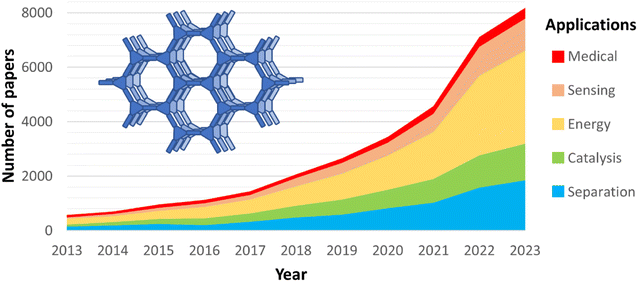Introduction to functional framework materials
Paolo
Falcaro
 *a,
Patricia
Horcajada
*a,
Patricia
Horcajada
 b and
Dan
Li
b and
Dan
Li
 c
c
aInstitute of Physical and Theoretical Chemistry, Graz University of Technology, Graz, 8010, Austria. E-mail: paolo.falcaro@tugraz.at
bAdvanced Porous Materials Unit, IMDEA Energy Institute, 28935 Móstoles-Madrid, Spain. E-mail: patricia.horcajada@imdea.org
cCollege of Chemistry and Materials Science, Jinan University, Guangzhou, China. E-mail: danli@jnu.edu.cn
Over the past decade, the exploration of functional framework materials – with notable examples that include metal–organic frameworks (MOFs), covalent–organic frameworks (COFs), hydrogen bonded-organic frameworks (HOFs) and porous organic polymers (POPs) – has generated new research areas in chemistry and materials science.1–5 The driving force to explore these materials is based on their unprecedented structural tunability and physicochemical properties. These materials stand at the forefront of scientific research due to their promising functionalities in separation, catalysis, energy conversion/storage, sensing, and medicine, to name a few relevant applications.3,6–15 We note that, over the last decade, these applications have attracted increasing scientific interest as shown by the stack area chart in Fig. 1.
With their typically ordered framework, high surface area, and tunable pore size, framework materials exhibit a uniquely high propensity to structural and functional customization, making them versatile platforms for tackling some of the most pressing global challenges for sustainability (see United Nations' 17 Sustainability Goals).16
The current themed collection, “Functional Framework Materials,” presents a meticulously curated set of over 70 papers (including 5 review articles and 2 communications), each contributing to the progress of this dynamic field.
The theme focuses on the design of new framework materials spanning from their synthesis, via traditional solvothermal and unconventional methods, to device fabrication and applications. We note that the use of unconventional synthetic approaches (e.g. vapor deposition, mechanochemistry) and the development of protocols for device fabrication, will progress the practical application of framework materials.17–20 Equally important in this collection, is the use of advanced computational and characterization methods that underscore the need for new tools for a deeper understanding of the material properties.21,22 This collection places a significant focus on MOFs, which are discussed in 44% of the papers. This emphasis reflects the established attention to their specific combination of organic and inorganic building blocks, yielding unique functional properties. COFs and porous polymers/cages, known for their robustness and designable structures, are the subject of 18% of the contributions, further illustrating the scientific community's effort to explore and expand the boundaries of organized organic structures. In addition to MOFs, COFs, and POPs, the collection encompasses a diverse array of materials including HOFs, carbon-based structures, zeolites, and more, expanding the scope to other extended materials.
The collection reveals the promising role of functional frameworks in energy: 37% of the papers are related to renewable energy production and storage. Catalysis and separation account for 22% and 20% of the contributions, respectively, highlighting the materials' efficiency in facilitating chemical transformations and purifying essential resources. Additionally, the collection includes valuable insights into sensing (6.6%), environmental remediation (3.3%), and biomolecule protection (3.3%), showcasing the broad applicability of these materials in detecting environmental pollutants, mitigating ecological impacts, and protecting valuable biomacromolecules.
This diversity of preparation methods, materials, and applications underscores the interdisciplinary nature of this research field that combines aspects of chemistry, physics, materials science, and engineering.
To highlight the quality of the collected studies, here we briefly discuss three selected examples.
Example 1: Vicent-Luna and Calero and colleagues (https://doi.org/10.1039/D3TA05258C) utilized molecular simulations to evaluate the effectiveness of five different metal–organic frameworks (MOFs) in adsorption-driven heat pumps with methanol and ethanol as working fluids. Their approach involved a detailed analysis of adsorption data along with a thermodynamic model to determine key properties such as coefficient of performance, working capacity, and specific heat. This research emphasizes the significance of enhancing the efficiency of adsorption-based heat pumps (AHPs) and adsorption cooling systems (ACSs) in order to decrease energy usage through the utilization of MOFs. Specifically, MAF-6 emerges as a promising candidate based on the findings presented in this study. The methodology presented in this work elucidates the operating mechanisms of the adsorption-driven heat pumps for heating and cooling with light alcohols as working fluids and the potential of MOF materials in such applications.23,24
Example 2: the Farha's group (https://doi.org/10.1039/D3TA07163D) proposed a new modification strategy to prepare Zr-phosphonate MOFs. This two-step post-modification method consists of replacing carboxylate linkers with phosphinate linkers, to then post-synthetically oxidize them to phosphonates. Indeed, the phosphonate-based hydroxyl group remains uncoordinated, resulting in more hydrophilic materials with increased Brønsted acidity. This modification platform provides an easy strategy to obtain versatile and tunable isoreticular robust Zr6-phosphinate/phosphonate MOFs, being potentially extended to other MOF families and/or benefiting from the digital reticular chemistry.25
Example 3: Patterson and co-workers (https://doi.org/10.1039/D3TA05397K) studied the influence of protein folding in prenucleation clusters on the efficiency of enzyme@MOF composites, particularly focusing on glucose oxidase and catalase encapsulated into zeolitic imidazolate frameworks-8 (ZIF-8). Through electron microscopy and spectroscopy analyses, the author reveals that the interaction between enzymes and MOF precursors during initial cluster formation is crucial for retaining enzyme activity. This research offers a new perspective on enzyme immobilization, emphasizing the importance of enzyme-MOF precursor interactions, potentially advancing industrial-scale enzyme@MOF applications. This work represents a milestone for the advancement of encapsulation and protection of enzymes26 as a way to improve sustainability aspects.27,28 We posit that similar investigations will be beneficial to other classes of protective matrices (e.g. HOF materials).
As we stand on the brink of a new era in materials science, the articles selected for this collection reflect the current advancement of framework materials research and provide directions for future investigations by highlighting their role in sustainable development. This editorial invites readers to explore the depths of functional framework materials, encouraging a multidisciplinary approach to harness their full potential in addressing some of the most pressing challenges of our time.
References
- H. Furukawa, K. E. Cordova, M. O'Keeffe and O. M. Yaghi, Science, 2013, 341, 1230444 CrossRef PubMed.
- H. S. Sasmal, A. Kumar Mahato, P. Majumder and R. Banerjee, J. Am. Chem. Soc., 2022, 144, 11482–11498 CrossRef CAS PubMed.
- R. Freund, O. Zaremba, G. Arnauts, R. Ameloot, G. Skorupskii, M. Dincă, A. Bavykina, J. Gascon, A. Ejsmont, J. Goscianska, M. Kalmutzki, U. Lächelt, E. Ploetz, C. S. Diercks and S. Wuttke, Angew. Chem., Int. Ed., 2021, 60, 23975–24001 CrossRef CAS PubMed.
- R.-B. Lin, Y. He, P. Li, H. Wang, W. Zhou and B. Chen, Chem. Soc. Rev., 2019, 48, 1362–1389 RSC.
- R. Dawson, A. I. Cooper and D. J. Adams, Prog. Polym. Sci., 2012, 37, 530–563 CrossRef CAS.
- C. Petit, Curr. Opin. Chem. Eng., 2018, 20, 132–142 CrossRef.
- K. Adil, Y. Belmabkhout, R. S. Pillai, A. Cadiau, P. M. Bhatt, A. H. Assen, G. Maurin and M. Eddaoudi, Chem. Soc. Rev., 2017, 46, 3402–3430 RSC.
- S. Yuan, X. Li, J. Zhu, G. Zhang, P. Van Puyvelde and B. Van Der Bruggen, Chem. Soc. Rev., 2019, 48, 2665–2681 RSC.
- X. Zhao, Y. Wang, D. Li, X. Bu and P. Feng, Adv. Mater., 2018, 30, 1705189 CrossRef.
- X. Liu, D. Huang, C. Lai, G. Zeng, L. Qin, H. Wang, H. Yi, B. Li, S. Liu, M. Zhang, R. Deng, Y. Fu, L. Li, W. Xue and S. Chen, Chem. Soc. Rev., 2019, 48, 5266–5302 RSC.
- L. Wang, Y. Han, X. Feng, J. Zhou, P. Qi and B. Wang, Coord. Chem. Rev., 2016, 307, 361–381 CrossRef CAS.
- L. Jiao, Y. Wang, H. Jiang and Q. Xu, Adv. Mater., 2018, 30, 1703663 CrossRef PubMed.
- I. Stassen, N. Burtch, A. Talin, P. Falcaro, M. Allendorf and R. Ameloot, Chem. Soc. Rev., 2017, 46, 3185–3241 RSC.
- M. Giménez-Marqués, T. Hidalgo, C. Serre and P. Horcajada, Coord. Chem. Rev., 2016, 307, 342–360 CrossRef.
- J. Yang and Y. Yang, Small, 2020, 16, 1906846 CrossRef CAS PubMed.
- J. Tollefson, Nature, 2023 DOI:10.1038/d41586-023-02970-2.
- T. Stolar and K. Užarević, CrystEngComm, 2020, 22, 4511–4525 RSC.
- R. Bo, M. Taheri, B. Liu, R. Ricco, H. Chen, H. Amenitsch, Z. Fusco, T. Tsuzuki, G. Yu, R. Ameloot, P. Falcaro and A. Tricoli, Advanced Science, 2020, 7, 2002368 CrossRef CAS PubMed.
- V. Rubio-Giménez, M. Galbiati, J. Castells-Gil, N. Almora-Barrios, J. Navarro-Sánchez, G. Escorcia-Ariza, M. Mattera, T. Arnold, J. Rawle, S. Tatay, E. Coronado and C. Martí-Gastaldo, Adv. Mater., 2018, 30, 1704291 CrossRef PubMed.
- J.-L. Zhuang, A. Terfort and C. Wöll, Coord. Chem. Rev., 2016, 307, 391–424 CrossRef CAS.
- Y. G. Chung, E. Haldoupis, B. J. Bucior, M. Haranczyk, S. Lee, H. Zhang, K. D. Vogiatzis, M. Milisavljevic, S. Ling, J. S. Camp, B. Slater, J. I. Siepmann, D. S. Sholl and R. Q. Snurr, J. Chem. Eng. Data, 2019, 64, 5985–5998 CrossRef CAS.
- V. Bon, E. Brunner, A. Pöppl and S. Kaskel, Adv. Funct. Mater., 2020, 30, 1907847 CrossRef CAS.
- M. F. De Lange, K. J. F. M. Verouden, T. J. H. Vlugt, J. Gascon and F. Kapteijn, Chem. Rev., 2015, 115, 12205–12250 CrossRef CAS PubMed.
- W. Li, X. Xia, M. Cao and S. Li, J. Mater. Chem. A, 2019, 7, 7470–7479 RSC.
- L. Gagliardi and O. M. Yaghi, Chem. Mater., 2023, 35, 5711–5712 CrossRef CAS.
- W. Liang, P. Wied, F. Carraro, C. J. Sumby, B. Nidetzky, C.-K. Tsung, P. Falcaro and C. J. Doonan, Chem. Rev., 2021, 121, 1077–1129 CrossRef CAS PubMed.
- S. Giaveri, A. M. Schmitt, L. Roset Julià, V. Scamarcio, A. Murello, S. Cheng, L. Menin, D. Ortiz, L. Patiny, S. Bolisetty, R. Mezzenga, S. J. Maerkl and F. Stellacci, Adv. Mater., 2021, 33, 2104581 CrossRef CAS PubMed.
- R. A. Sheldon, A. Basso and D. Brady, Chem. Soc. Rev., 2021, 50, 5850–5862 RSC.
| This journal is © The Royal Society of Chemistry 2024 |




